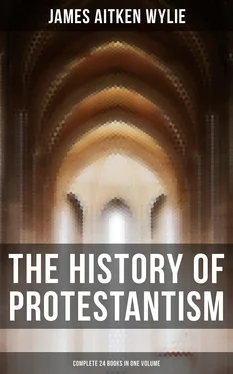And here let us interpose an observation. We speak at times of the signal benefits which the "Church" conferred upon the Gothic nations during the Middle Ages. She put herself in the place of a mother to those barbarous tribes; she weaned them from the savage usages of their original homes; she bowed their stubborn necks to the authority of law; she opened their minds to the charms of knowledge and art; and thus laid the foundation of those civilized and prosperous communities which have since arisen in the West. But when we so speak it behooves us to specify with some distinctness what we mean by the "Church" to which we ascribe the glory of this service. Is it the Church of Rome, or is it the Church universal of Christendom? If we mean the former, the facts of history do not bear out our conclusion. The Church of Rome was not then the Church, but only one of many Churches. The slow but beneficent and laborious work of evangelizing and civilizing the Northern nations, was the joint result of the action of all the Churches — of Northern Italy, of France, of Spain, of Germany, of Britain — and each performed its part in this great work with a measure of success exactly corresponding to the degree in which it retained the pure principles of primitive Christianity. The Churches would have done their task much more effectually and speedily but for the adverse influence of Rome. She hung upon their rear, by her perpetual attempts to bow them to her yoke, and to seduce them from their first purity to her thinly disguised paganisms. Emphatically, the power that molded the Gothic nations, and planted among them the seeds of religion and virtue, was Christianity — that same Christianity which apostles preached to men in the first age, which all the ignorance and superstition of subsequent times had not quite extinguished, and which, with immense toil and suffering dug up from under the heaps of rubbish that had been piled above it, was anew, in the sixteenth century, given to the world under the name of Protestantism.
CHAPTER 6
THE WALDENSES — THEIR VALLEYS
Table of Contents
Submission of the Churches of Lombardy to Rome — The Old Faith maintained in the Mountains — The Waldensian Churches — Question of their Antiquity — Approach to their Mountains — Arrangement of their Valleys — Picture of blended Beauty and Grandeur.
WHEN Claude died it can hardly be said that his mantle was taken up by any one. The battle, although not altogether dropped, was henceforward languidly maintained. Before this time not a few Churches beyond the Alps had submitted to the yoke of Rome, and that arrogant power must have felt it not a little humiliating to find her authority withstood on what she might regard as her own territory. She was venerated abroad but contemned at home. Attempts were renewed to induce the Bishops of Milan to accept the episcopal pall, the badge of spiritual vassalage, from the Pope; but it was not till the middle of the eleventh century (1059), under Nicholas II., that these attempts were successful. Petrus Damianus, Bishop of Ostia, and Anselm, Bishop of Lucca, were dispatched by the Pontiff to receive the submission of the Lombard Churches, and the popular tumults amid which that submission was extorted sufficiently show that the spirit of Claude still lingered at the foot of the Alps. Nor did the clergy conceal the regret with which they laid their ancient liberties at the feet of a power before which the whole earth was then bowing down; for the Papal legate, Damianus, informs us that the clergy of Milan maintained in his presence, "That the Ambrosian Church, according to the ancient institutions of the Fathers, was always free, without being subject to the laws of Rome, and that the Pope of Rome had no jurisdiction over their Church as to the government or constitution of it."
But if the plains were conquered, not so the mountains. A considerable body of Protesters stood out against this deed of submission. Of these some crossed the Alps, descended the Rhine, and raised the standard of opposition in the diocese of Cologne, where they were branded as Manicheans, and rewarded with the stake. Others retired into the valleys of the Piedmontese Alps, and there maintained their scriptural faith and their ancient independence. What we have just related respecting the dioceses of Milan and Turin settles the question, in our opinion, of the apostolicity of the Churches of the Waldensian valleys. It is not necessary to show that missionaries were sent from Rome in the first age to plant Christianity in these valleys, nor is it necessary to show that these Churches have existed as distinct and separate communities from early days; enough that they formed a part, as unquestionably they did, of the great evangelical Church of the north of Italy. This is the proof at once of their apostolicity and their independence. It attests their descent from apostolic men, if doctrine be the life of Churches. When their co-religionists on the plains entered within the pale of the Roman jurisdiction, they retired within the mountains, and, spurning alike the tyrannical yoke and the corrupt tenets of the Church of the Seven Hills, they preserved in its purity and simplicity the faith their fathers had handed down to them. Rome manifestly was the schismatic, she it was that had abandoned what was once the common faith of Christendom, leaving by that step to all who remained on the old ground the indisputably valid title of the True Church.
Behind this rampart of mountains, which Providence, foreseeing the approach of evil days, would almost seem to have reared on purpose, did the remnant of the early apostolic Church of Italy kindle their lamp, and here did that lamp continue to burn all through the long night which descended on Christendom. There is a singular concurrence of evidence in favor of their high antiquity. Their traditions invariably point to an unbroken descent from the earliest times, as regards their religious belief. The Nobla Leycon, which dates from the year 1100, goes to prove that the Waldenses of Piedmont did not owe their rise to Peter Waldo of Lyons, who did not appear till the latter half of that century (1160). The Nobla Leycon, though a poem, is in reality a confession of faith, and could have been composed only after some considerable study of the system of Christianity, in contradistinction to the errors of Rome. How could a Church have arisen with such a document in her hands? Or how could these herdsmen and vine-dressers, shut up in their mountains, have detected the errors against which they bore testimony, and found their way to the truths of which they made open profession in times of darkness like these? If we grant that their religious beliefs were the heritage of former ages, handed down from an evangelical ancestry, all is plain; but if we maintain that they were the discovery of the men of those days, we assert what approaches almost to a miracle. Their greatest enemies, Claude Seyssel of Turin (1517), and Reynerius the Inquisitor (1250), have admitted their antiquity, and stigmatized them as "the most dangerous of all heretics, because the most ancient."
Rorenco, Prior of St. Roch, Turin (1640), was employed to investigate the origin and antiquity of the Waldenses, and of course had access to all the Waldensian documents in the ducal archives, and being their bitter enemy he may be presumed to have made his report not more favorable than he could help. Yet he states that "they were not a new sect in the ninth and tenth centuries, and that Claude of Turin must have detached them from the Church in the ninth century."
Within the limits of her own land did God provide a dwelling for this venerable Church. Let us bestow a glance upon the region. As one comes from the south, across the level plain of Piedmont, while yet nearly a hundred miles off, he sees the Alps rise before him, stretching like a great wall along the horizon. From the gates of the morning to those of the setting sun, the mountains run on in a line of towering magnificence. Pasturages and chestnut-forests clothe their base; eternal snows crown their summits. How varied are their forms! Some rise strong and massy as castles; others shoot up tall and tapering like needles; while others again run along in serrated lines, their summits torn and cleft by the storms of many thousand winters. At the hour of sunrise, what a glory kindles along the crest of that snowy rampart! At sunset the spectacle is again renewed, and a line of pyres is seen to burn in the evening sky.
Читать дальше












